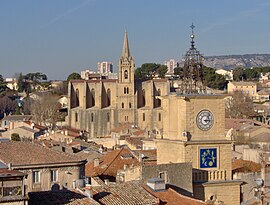Salon-de-Provence
| Salon-de-Provence | ||
|---|---|---|

A view of Salon-de-Provence, with the church and clock tower
|
||
|
||
| Coordinates: 43°38′26″N 5°05′50″E / 43.6406°N 5.0972°ECoordinates: 43°38′26″N 5°05′50″E / 43.6406°N 5.0972°E | ||
| Country | France | |
| Region | Provence-Alpes-Côte d'Azur | |
| Department | Bouches-du-Rhône | |
| Arrondissement | Aix-en-Provence | |
| Canton | Salon-de-Provence | |
| Intercommunality | Salon-Étang de Berre-Durance | |
| Government | ||
| • Mayor (2014-2020) | Nicolas Isnard (UMP) | |
| Area1 | 70.3 km2 (27.1 sq mi) | |
| Population (2012)2 | 43,771 | |
| • Density | 620/km2 (1,600/sq mi) | |
| Time zone | CET (UTC+1) | |
| • Summer (DST) | CEST (UTC+2) | |
| INSEE/Postal code | 13103 / 13300 | |
| Elevation | 53–325 m (174–1,066 ft) | |
|
1 French Land Register data, which excludes lakes, ponds, glaciers > 1 km² (0.386 sq mi or 247 acres) and river estuaries. 2Population without double counting: residents of multiple communes (e.g., students and military personnel) only counted once. |
||
1 French Land Register data, which excludes lakes, ponds, glaciers > 1 km² (0.386 sq mi or 247 acres) and river estuaries.
Salon-de-Provence is a commune in the Bouches-du-Rhône department in southern France. It is the location of an important air base.
Salon was a Gallo-Roman oppidum well positioned on the salt trade routes between Adriatic, Atlantic and Mediterranean seas, hence its name. This region was under the Phocaean influence since the sixth century BCE, and stretches of the Via Aurelia can still be recognized just outside the town, but the earliest mention of the place under its familiar name is of the ninth century, as Villa Salone. The archbishops of Arles controlled the site.
Its principal claim to fame today is as the place where Nostradamus spent his last years and is buried. His dwelling is maintained as a museum, and for four days every June or July, the city celebrates its history during the time of Nostradamus, attracting tourists.
The historic center still lies within its circuit of walls, entered through two seventeenth-century gateways, the Porte de l'Horloge and the Port Bourg Neuf. In the sixteenth century Adam de Craponne built the canal that still bears his name; inexpensive freight brought commerce to Salon, and the town prospered.
The castle, which was the biggest in Provence during the 12th and 13th centuries and was mentioned as early as the tenth, still dominates the old town. It was the preferred residence of the bishops of Arles, when Provence was part of the Holy Roman Empire, hence its name. It became the property of the city after the French Revolution. After damage caused by the 1909 earthquake, it has been restored and now hosts a museum of military history. Every summer, it hosts an international classical music festival.
...
Wikipedia



